CURRENT AFFAIRS
12 OCTOBER 2019
BY SUMIT
IMPORTANT TOPICS IN THE CONTEXT OF INTERNATIONAL RELATIONS,INDIAN HISTORY,
INDIAN POLITY,ECONOMY AND SOCIETY,ENVIRONMENT for TODAY TO LOOK AT .
1.Arjuna’s Penance, Panch(five) rathas, Shore Temple(gs-1,2)
- Context:Modi, Xi resolve to work together to face challenge of terrorism and radicalisation
2.Ethiopian PM Abiy Ahmed wins Nobel Peace Prize
- Ethiopian Prime Minister Abiy Ahmed has won the 2019 Nobel Peace Prize for his peacemaking efforts with Eritrea.
3.IIP....GS-3
- CONTEXT:INDUSTRIAL PRODUCTION DROPS BY 1.1% IN AUGUST
4.CLEAN AIR CITIES DECLARATION(GS-2,3)
- CONTEXT:Arvind Kejriwal announces task force to monitor implementation of C40 clean air declaration
5.Chalukyan kings (gs-1)
- Context: Explorer stumbles upon ‘graves’ of Chalukyan kings in Pattadakal in Karnataka.
6.RTI(GS-2)
- CONTEXT: Penalties levied for RTI violations in 3% of cases in 2018-19
1.Arjuna’s Penance, Panch(five) rathas, Shore Temple
(gs-1,2)
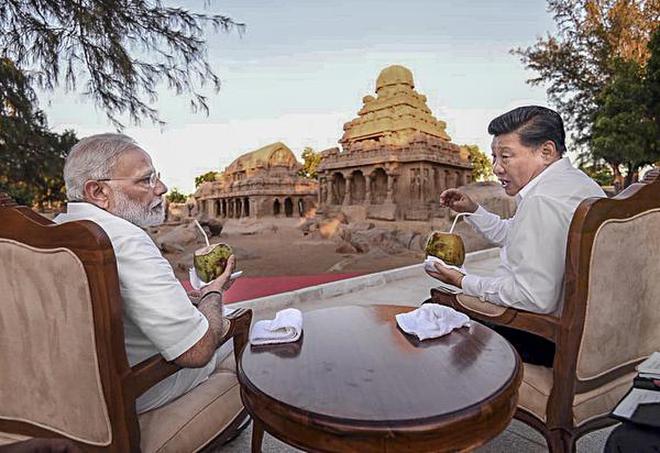
- Context:Modi, Xi resolve to work together to face challenge of terrorism and radicalisation
- The two leaders began their two-day second ‘informal summit’ at Mamallapuram
- The discussions also covered historical and trade links between Tamil Nadu under Pallava and Chola dynasties, and the eastern coast city of Quanzhou in Fujiyan Province, where Tamil inscriptions and fragments of architecture, reflecting a possible temple built by Tamil traders in the 12th Century CE, were recently discovered. Mr. Xi and Mr. Modi deliberated upon the possibility of enhancing knowledge in this area.
Arjuna’s Penance:
Mamallapuram

- This magnificent relief, carved in the mid-seventh century, measures approximately 30m (100ft) long by 15m (45ft) high. Its huge size and scale is difficult to imagine just from photographs; a person standing on the ground in front of it could barely touch the elephants' feet.
- The subject is either Arjuna's Penance or the Descent of the Ganges, or possibly both. In additive cultures like India's, logical alternatives are often conceptualized as "both-and" rather than "either-or."
- Arjuna's Penance is a story from the Mahabharata of how Arjuna, one of the Pandava brothers, performed severe austerities in order to obtain Shiva's weapon. The idea, which pervades Hindu philosophy, is that one could obtain, by self-mortification, enough power even to overcome the gods. In order to protect themselves, the gods would grant the petition of any ascetic who threatened their supremacy in this way - a kind of spiritual blackmail, or "give to get." (This meaning of the word "penance," by the way, is specific to Hinduism. Unlike the Catholic rite of penance, it is performed to gain power, not to expiate sin.)
- The Ganges story is of the same kind, in which the sage Bhagiratha performs austerities in order to bring the Ganges down to earth. Shiva had to consent to break her fall in his hair, because otherwise its force would be too great for the earth to contain.
- The symbolism of the relief supports both stories. Furthermore, both stories were interpreted in a manner flattering to the Pallavas; the heroic Arjuna as a symbol of the rulers, and the Ganges as a symbol of their purifying power.
- The composition of the relief includes the main elements of the story (left) and scenes of the natural and celestial worlds (right). A natural cleft populated by nagas separates the two halves of the relief. Water was poured down this cleft in order to simulate a natural waterfall (the Ganges' descent). To the left, just above the shrine, Arjuna (or Bhagiratha) stands on one leg, his arms upraised, in a yoga posture. Behind him appears Shiva, holding a weapon and attended by ganas. To the right of the cleft, life-sized elephants protect their young below a scene of numerous other animals and flying celestials, all carved with the greatest vivacity, skill, naturalism, and joyousness.
Panch(five) rathas(Mamallapuram)
- Pancha Rathas also referred as Pandava Rathas are the most excellent architectural edifices of the nine monolithic temples of Mahabalipuram situated on the Coromandel Coast of the Bay of Bengal, near Chennai. The five structures each chiselled in the shape of rathas or chariots out of large block of stone or monolith of granite typifies monolithic Indian rock-cut architecture that dates back to the 7th century during the reign of the Pallava dynasty.
- The five rathas are named as ‘Dharmaraja Ratha’, ‘Bhima Ratha’, ‘Arjuna Ratha’, ‘Nakula Sahadeva Ratha’, and ‘Draupadi Ratha’ after the five Pandava brothers and their common spouse Draupadi from the great Indian epic ‘Mahabharata’. Although unfinished and never consecrated, these rathas that are often erroneously referred as temples are now part of the monument complex that is marked as ‘Group of Monuments at Mahabalipuram’ by ‘UNESCO’.
- It is enlisted in UNESCO’s World Heritage sites. Maintained under the patronage of the ‘Archaeological Survey of India’ (ASI), this complex has remained one of the famous tourist destinations of south India that became exemplar of and laid the foundation of a new architectural style, the temple architecture of South India.
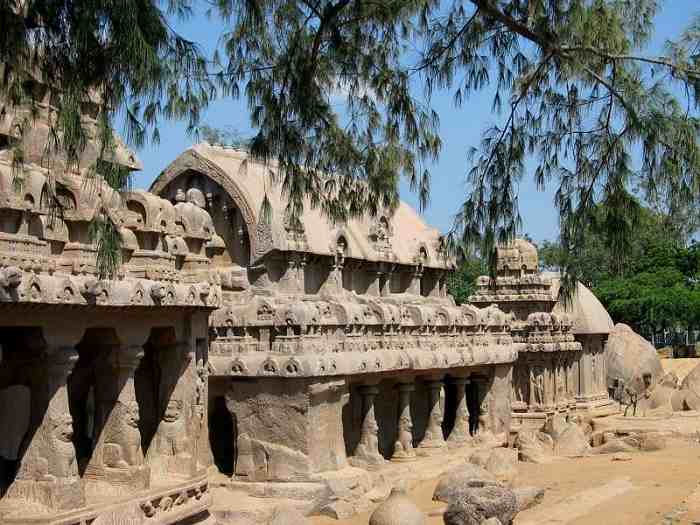
History
- The construction of the five rathas is traced back to the 7th century during the reign of King Mahendravarman I from 600–630 CE and his son Narasimhavarman I from 630–668 AD of the Pallava dynasty. An ASI inscribed tablet at the site mentions that the concept of carving the rocks in the shape of chariots or rathas was made by the Pallava dynasty keeping wooden rathas as prototypes. Construction work of the structures stopped after the demise of Narasimhavarman I in 668 AD. These structures illustrating the Dravidian architecture later became templates to temples of much higher dimensions constructed in the region subsequently. The reason for constructing the rathas, most of which have reflections of the Buddhist Viharas and Chaityas is not known till date. Although there is no connection between the structures and the Pandavas of the great Indian epic, the ‘Mahabharata’, and ASI proposed referring the structures as vimanas, but the names of Pandavas has incessantly remained linked with the structures. In 1984 UNESCO marked the place as World Heritage Site.
Dharmaraja Ratha
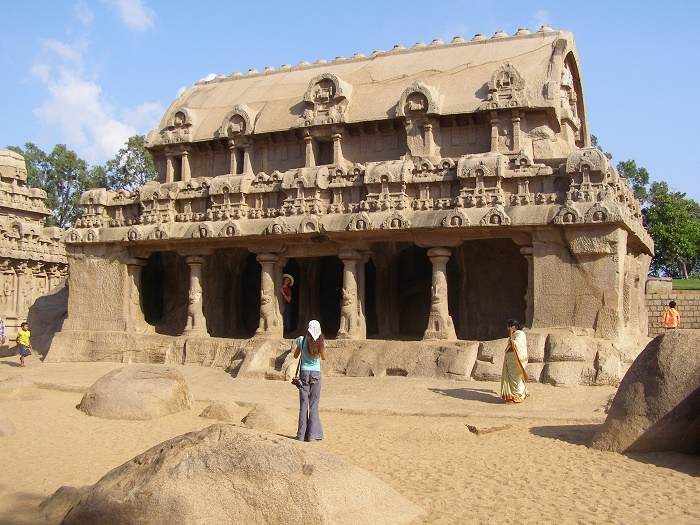
- The most imposing and architecturally superior structure as also the largest and soaring among the five rathas is the Dharmaraja Ratha. Dedicated to Lord Shiva, this elaborately sculptured tritala or three-storied vimana facing west has square talas with the ground floor measuring a square of 8.5 m with a height of 11 m. The facades of each of its four sides rest on two pillars and two pilasters. Features of the vimana includes open porches, progressively smaller storeys giving the structure the shape of a pyramidal tower having terrace and a shikhara, octagonal in shape, at the apex. The corners of the sanctum are adorned with several sculptures that include simple forms of Shiva, Krishna, Skanda, Brahma-Sasta, Harihara, Brahma and Ardhanarisvara. A portrait of a king, presumably that of Narasimhavarman I with inscriptions of his titles, Megha and Trailokiya –vardhana-vidhi etched above it finds place besides the sculptures. Name of the sanctum ‘Atyantakama Pallavesvaram’ is etched in the uppermost tier. ‘Atyantakama’ is considered a title of Paramesvaravarman I. The upper portion of the structure is decorated with kudus or horseshoe-arch dormer like projections. Sculptures of lions in sitting position are constructed to support the shafts of the pillars. The first floor is ornate with 22 carvings including the ones illustrating Lord Shiva as Natesa and Gangadara and Lord Krishna dancing atop Kaliya Mardhana and resting on Garuda. The second floor also contains rich carvings with several figures like that of Somaskanda and Dakshinamurthy.
Bhima Ratha
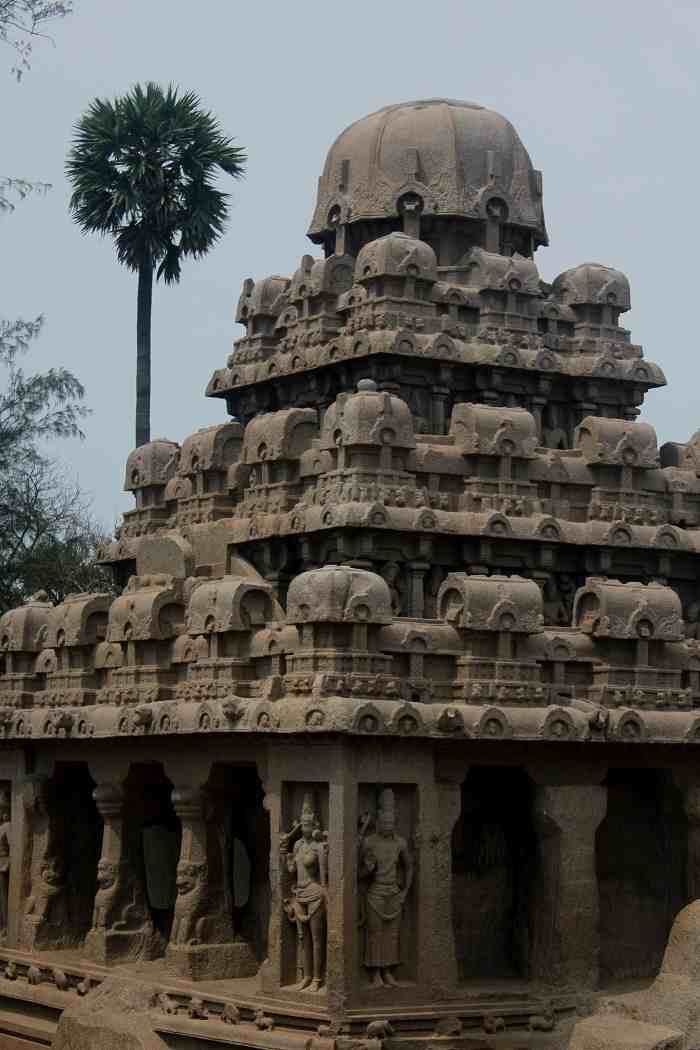
This ektala vimana facing west is an oblong structure with a base measuring 12.8 m by 7.3 m and a height of 7.6 m. It reminds one of the Buddhist cave architecture like the Sala-Shikhara. Dedicated to Lord Vishnu, this structure has a barrel-vaulted terrace and decorated columned porch, suggestive of palace architectural style. It is chiselled out of a pink granite boulder which soars gradually from north to south. The lower floor of the vimana, although incomplete indicates the plan that was chalked out for the floor that include a pillar-rested circumambulatory passage. It has open veranda with long pillars, lion mounted columned galleries on both long sides and kudus. Such embellishments are sculpted on the façade of the structure atop the cornices that demarks the two floors. The cornices connected to a passage are carved with oblong-shaped shrines. The gable ends are embellished with beautiful motifs while the interior of the vimana are inscribed with Nasikas.
Arjuna Ratha
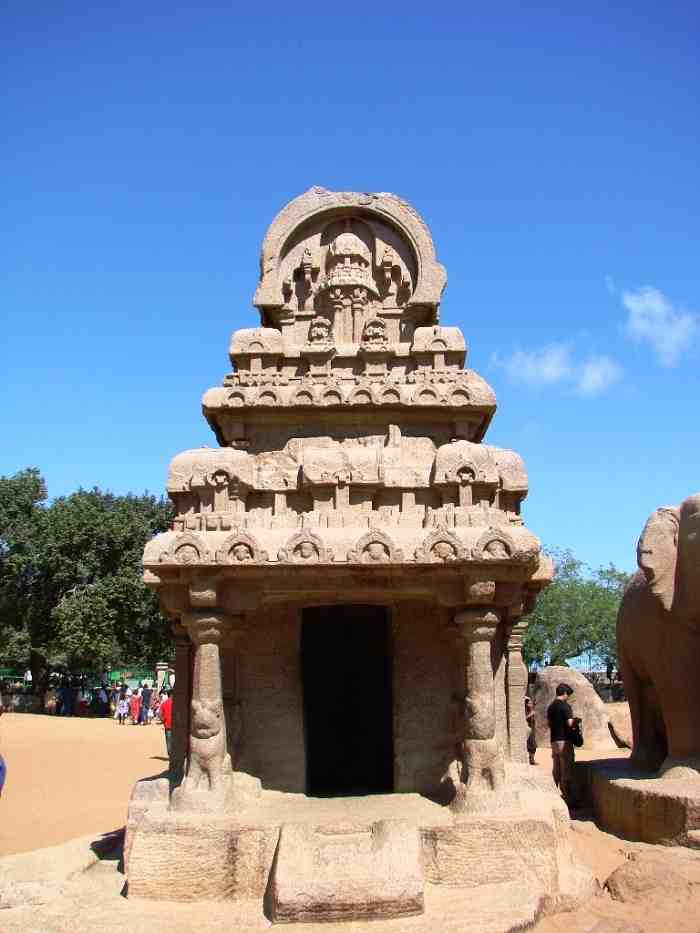
- This dvi-tala or two tiered vimana facing west and carved out of a live rock measuring 3.5 m by 4.9 m with a height of 6.1 m is dedicated to Lord Shiva. It shares the same upapitha or secondary platform with the Draupadi Ratha. The structure of the Arjuna Ratha is quiet simple and looks like a small palace. Although very much akin to the Dharmaraja Ratha, it differs from the latter in some respects which includes having one tier less than the latter, shape of the dome being octagonal and front yard adorned with a finely chiselled stone lion. The garbhagriha or sanctum sanctorum has a pillared Mukhamandapa or inner porch. The entrance of the ratha rests on two pillars and two lion mounted carved pilasters. The four sides of the cornices are decorated with kudus. Simple Padabandha style is manifested from the architecture of the adhisthana which is the platform of the main deity. In-between the exquisitely carved pillars lies slit-niches that consist of figures of several deities like Siva-Vrishabhantika, Skanda on an elephant and Vishnu as also figures of apsaras, a Siddha, Parthiharas, a Chowri bearer and Amaras to mention a few. The 8 niches of the second storey consist of carved figures of couples. A figure of Lord Shiva’s mount, Nandi the bull, is housed on the rear of the ratha.
Nakula Sahadeva Ratha

- This ratha dedicated to Lord Indra was named after the twins Nakula and Sahadeva, the last two of the Pandava brothers. It is the only ratha among the five that faces south and to some extent resembles a Chaitya Hall that is a Buddhist prayer hall. As the structure looks like backside of an elephant, it is referred as ‘Gajaprishtakara’ and the style as ‘gajapristha’. A monolithic sculpture of an elephant also finds place beside the ratha. Constructed on the same base as that of the Dharmaraja, Bhima and Arjuna rathas, this dvitala or two tiered structure has an apsidal plan. Although the ratha is devoid of any idol to worship, carved figures of gods and demi-gods adorn the niches of its interior walls.
Draupadi Ratha
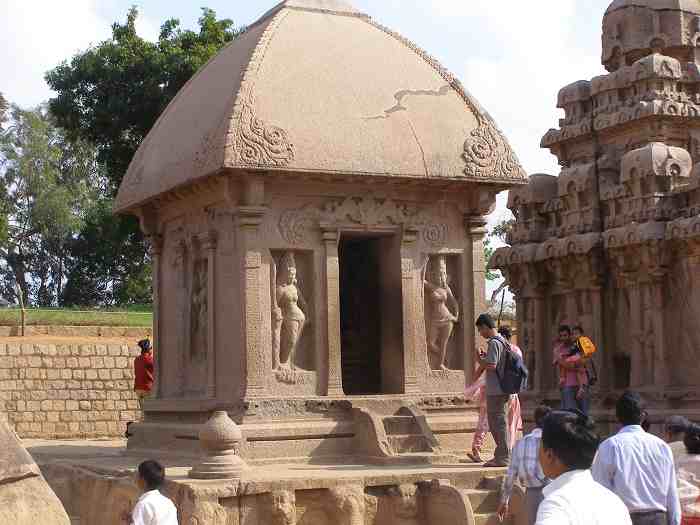
- Named after the common wife of the Pancha Pandavas, this ratha which lies at the northern end of the five rathas is dedicated to Goddess Durga. Constructed in the form of a small hut of Bengal, it is the smallest of the five rathas, and measures 3.4 m by 3.4 m with a height of 5.5 m. The curvilinear thatched roof is devoid of any finial but is embellished with motifs in the joints. The high rise platform leading to the entrance door of the west facing ratha is decorated with sculptures of lion and elephant heads chiselled alternately. Durga images adorn the ratha, particularly on the sanctum that portrays Goddess Durga standing on a lotus and also on the exterior surface of the wall facing east.
Shore Temple(Mamallapuram)
Seashore as canvas
Along the shores of one of the largest bays in the world, the Bay of Bengal, stands a temple complex that draws inspiration from the sea and its naturally occurring rock formations. The majestic Shore Temple (known locally as Alaivay-k-kovil) sits beside the sea in the small town of Mamallapuram in the state of Tamil Nadu in India. This complex of three separate shrines was constructed under the patronage of the Pallava king Nrasimhavarman II Rajasimha, who ascended the throne in 700 C.E. and ruled for about twenty years.
The Pallavas and the city of Mamallapuram
Mamallapuram, also known as Mahabalipuram, was an important port town during India’s early history and developed as a key center for artistic activity under the patronage of the Pallava rulers. Nrasimhavarman I, who took the epithet Mamalla (meaning “great warrior”), ruled for about 38 years beginning in 630 C.E. and sponsored a large number of rock-cut monuments at Mamallapuram, including cave shrines, monolithic temples, and large sculptures carved out of boulders. While the Pallava kings primarily worshipped the god Shiva, they also supported the creation of temples dedicated to other Hindu gods and goddesses and to other religious traditions such as
. The Pallava rulers were particularly inspired by the growing personal devotional movement known as bhakti, in which worshippers approach the divine as a cherished child or loved one.
. The Pallava rulers were particularly inspired by the growing personal devotional movement known as bhakti, in which worshippers approach the divine as a cherished child or loved one.
A temple in Dravidian style
Indian temple architecture can be broadly divided into two schools: theNagara, or the North Indian tradition, and the Dravidian, or South Indian style of architecture. Both Nagara and Dravidian temples consist of a main shrine (vimana) which houses the inner sanctum known as grabha griha (literally “womb chamber”), topped by a pyramidal tower known as a shikhara.
At the Shore Temple, the entire superstructure has an octagonal neck (griva) topped by a round stupi or finial. Dravidian temples are typically enclosed within an outer wall (prakara, shown below) with a large gateway tower known as a gopura.
The development of early Indian architecture demonstrates a progression from structures of wood and timber to cave shrines, rock cut structures, and eventually freestanding temples constructed out of mortar and stone. Cave shrines were dug into cliffs and hills and their scheme and ornamentation clearly exhibit the continuing influence of traditions used in earlier wooden structures. The rock cut temples were constructed out of large freestanding boulders that artists would work by carving the rocks from the top to the bottom on both the exterior and interior simultaneously.
A temple with three shrines
The Shore Temple is both a rock cut and a free-standing structural temple. The entire temple stands on a naturally occurring granite boulder. The complex consists of three separate shrines: two dedicated to the god Shiva, and one to Vishnu. The Vishnu shrine is the oldest and smallest of the three shrines, The other elements of the temple, including the gateways, walls, and superstructures were constructed out of quarried stone and mortar.
The entrance to the temple complex is from the western gateway, facing the smaller Shiva shrine. On each side of the gateway stand door guardians known as dvarapalas who welcome visitors to the complex and mark the site as sacred. The smaller Vishnu temple sits between the two Shiva shrines, connecting the two. It has a rectangular plan with a flat roof and houses a carved image of the god Vishnu sleeping. Images of Vishnu reclining or sleeping on the cosmic serpent Shesha-Ananta, appear throughout Indian art. While the artists who made this carving did not include a depiction of Shesha-Ananta, it is possible that originally the rock was painted to include the snake. The shrine walls have carvings depicting the life stories of Vishnu and one of his avatars, Krishna.
Like the Vishnu shrine, the two Shiva shrines include rich sculptural depictions on both their inner and outer walls. The large Shiva shrine faces east, and has a square plan with a sanctum and a small pillared porch known as a mandapa. At the center of the shrine is a lingam, the aniconic form of Shiva in the shape of a phallus. Though the temple is not a site of active worship today, visitors can sometimes be seen worshipping and offering flowers to the lingam, bringing the sacred site back to life.
On the back wall of the shrine appear carvings of Shiva (this time in anthropomorphic or human-like form) with his consort, the goddess Parvati, and their son Skanda. The inner walls of the mandapa contain images of the gods Brahma and Vishnu, and the outer north wall of the sanctum includes more sculptures of Shiva as well as a depiction of the goddess Durga. The small Shiva shrine faces west and has a square plan with a sanctum and twomandapas. As with the larger Shiva shrine, the smaller shrine’s sanctum originally housed a lingam, which is now missing. A sculpted panel depicting Shiva, Parvati, and Skanda enlivens the back wall. Both Shiva shrines have identical multi-storied pyramidal superstructures typical of the Dravidian style.
The rich sculptural program seen throughout the three shrines continues on the outer walls of the Shore Temple, facing the sea. Years of wind and water have worn away the details of these carvings, much in the same way that the sea erodes and shapes boulders over centuries. A row of seated bulls appear at the entrance wall (prakara) of the larger Shiva shrine. These bulls represent Nandi, the vahana or vehicle of the god Shiva. Nandi is believed to be the guardian of Shiva’s home in the Himalayas, Mount Kailasha, and a seated Nandi sculpture is an essential part of a Shiva temple.
A majestic sight
As an architectural form, the Shore Temple is of immense importance, situated on the culmination of two architectural phases of Pallava architecture: it demonstrates progression from rock cut structures to free standing structural temples, and displays all the elements of mature Dravidian architecture. It signifies religious harmony with sacred spaces dedicated to both Shiva and Vishnu, and was also an important symbol of Pallava political and economic strength.
According to legend, sailors and merchants at sea could spot the shikharas of the temple from a distance and use those majestic towers to mark their arrival to the prosperous port city of Mahabalipuram. In this way, not only was the temple a home for the gods Shiva and Vishnu, but also a feature of the landscape, and an icon of the dominion of the great Pallava kings.
resources:Michael W. Meister, ed., Encyclopeadia of Indian Temple Architecture: South India Lower Drāviḍadēśa 200 B.C.-A.D.1324, vol. I, part I (New Delhi: American Institute of Indian Studies, 1983)Susan L. Huntington, The Art of Ancient India: Buddhist, Hindu, Jain (New York: Weatherhill, 1985)R. Nagaswamy, Mahabalipuram (New Delhi: Oxford University Press, 2008)
2.Ethiopian PM Abiy Ahmed wins Nobel Peace Prize
- Ethiopian Prime Minister Abiy Ahmed has won the 2019 Nobel Peace Prize for his peacemaking efforts with Eritrea.
- Ethiopia and Eritrea, longtime foes who fought a border war from 1998 to 2000, restored relations in July 2018 after years of hostility. The prize will be presented in Oslo on Dec. 10.
BREAKING NEWS:— The Nobel Prize (@NobelPrize) October 11, 2019
The Norwegian Nobel Committee has decided to award the Nobel Peace Prize for 2019 to Ethiopian Prime Minister Abiy Ahmed Ali.#NobelPrize #NobelPeacePrize pic.twitter.com/uGRpZJHk1B
3.INDEX OF INDUSTRIAL PRODUCTION(IIP)(GS-3)
- CONTEXT: Industrial production drops by 1.1% in August
- SIgns of slowdown became more pronounced as the government data on Friday revealed factory output shrank by 1.1% in August, recording the poorest performance in seven years due to a sharp decline in production of capital goods and consumer durable.
- Industrial production growth for the first time in more than two years has treaded into negative territory.
- The Index of Industrial Production (IIP) had shown a growth of 4.8% in August 2018. The previous low in IIP was (-) 1.7% in November 2012.
INDEX OF INDUSTRIAL PRODUCTION(IIP):
- Index of Industrial Production (IIP) is an index which helps us understand the growth of various sectors in the Indian economy such as mining, electricity and manufacturing.
- IIP is a short term indicator of industrial growth till the results from Annual Survey of Industries (ASI) and National Accounts Statistics (Eg: GDP) are available.
- The base year of the index is given a value of 100. The current base year for the IIP series in India is 2011-12. So, if the current IIP reads 180, it means that there has been 80% industrial growth compared to the base year, ie 2011-12.
Who releases IIP?
- Index of Industrial Production (IIP) is released by the Central Statistics Office (CSO) of the Ministry of Statistics and Programme Implementation.
- IIP is published monthly, six weeks after the reference month ends.
- Annual Survey of Industries (ASI) Vs Index of Industrial Production (IIP)
- The Industrial Output data is captured and monitored, primarily, through two statistical activities – Annual Survey of Industries (ASI) and Index of Industrial Production (IIP).
ASI
- ASI is calculated on an annual basis
- The ASI is conducted under the Collection of Statistics Act, since 1959.
- The objective is to obtain comprehensive and detailed statistics of industrial sector with the objective of estimating the contribution of registered manufacturing industries as a whole to the national income.
- ASI data is based on the actual book of accounts and other documents maintained by registered factories.
IIP
- IIP is calculated on a monthly basis.
- Data for IIP are collected by various source agencies under different Acts/statutes.
- The IIP is compiled on the basis of data sourced from 16 ministries/ administrative departments.
4.CLEAN AIR CITIES DECLARATION(GS-2,3)
- CONTEXT:Arvind Kejriwal announces task force to monitor implementation of C40 clean air declaration
- Delhi chief minister Arvind Kejriwal on Friday attended the C40 Cities Summit in Copenhagen through a video link and announced formation of a special task force to monitor implementation of 'Clean Air Cities Declaration' signed at the meet.
- "I am very happy to announce that New Delhi is joining 37 other cities from around the world in signing the C40 'Clean Air Cities Declaration'. I am able to confidently sign this declaration because of the support of two crore residents of Delhi, who are my strength," he said. Earlier, addressing a joint conference along with mayors of various world cities, Kejriwal announced formation of a special task force to monitor Delhi's progress towards meeting the goals of the 'Clean Air Cities Declaration'
- Besides Kejriwal, mayors of Paris, Copenhagen, Barcelona, Los Angeles and other cities also spoke at the joint conference.
C40 cities climate summit :
The C40 Summit is to take place in Copenhagen between 9th October and 12th October, 2019. The aim of the summit is to show how cities are delivering their strong commitments for healthier, sustainable, resilient and inclusive future. The 2019 summit in specific aims to build global coalition of cities, citizens and businesses that rallies around ambitious climate action that the earth needs right now.About C40
The summit connects more than 94 of the world’s greatest cities. The cities constitute to more than 700 million population which is one – fourth of the global economy. The mayors of these cities are dedicated in delivering the goals of Paris Agreement. The 2019 marks 14 – year establishment of C40 Leadership group. The organization takes its climate actions through city – to – city collaboration. The summit intends to Paris agreement of climate change as well. The summit was launched in London in 2005 when the then London Mayor convened representatives from 18 megacities.
5.Chalukyan kings (gs-1)
- Context: Explorer stumbles upon ‘graves’ of Chalukyan kings in Pattadakal in Karnataka.
- Graves of Chalukyan rulers have been found in a village near Huligemmanakolla in Pattadakal of Bagalkot district.
- The discovery has been made by explorer Manjunath Sullolli who says that the place is nothing but where graves of the family members of Chalukyan rulers are located.
- Mr. Sullolli, who has made a mention of this in his upcoming book “Exploring the Chalukyan land, the largest temple monument of India”, said that the Chalukyan kings were famous for building gigantic temples with intricate architecture in places such as Aihole, Badami and Pattadakal in Bagalkot district.
- Built between the sixth and eighth centuries, these monuments are examples of the best of architecture of that era in the entire South India, he said.
- Mr. Sullolli said that though the Chalukyan kings built marvellous monuments and temples, there are no clear details available of the places where they lived.
- This temple has 11 smaller temple-like structures. According to Mr. Sullolli, these 11 smaller temples are nothing but the graves of the family members of the Chalukyan kings.
| The temple near Huligemmanakolla in Pattadakal of Bagalkot district which is said to contain the graves of Chalukyan kings. |
Chalukya dynasty:
- The Chalukya dynasty was a Classical Indian royal dynasty that ruled large parts of southern and central India between the 6th and the 12th centuries. During this period, they ruled as three related yet individual dynasties. The earliest dynasty, known as the "Badami Chalukyas", ruled from Vatapi (modern Badami) from the middle of the 6th century. The Badami Chalukyas began to assert their independence at the decline of the Kadamba kingdom of Banavasi and rapidly rose to prominence during the reign of Pulakeshin II. After the death of Pulakeshin II, the Eastern Chalukyas became an independent kingdom in the eastern Deccan. They ruled from Vengi until about the 11th century. In the western Deccan, the rise of the Rashtrakutas in the middle of the 8th century eclipsed the Chalukyas of Badami before being revived by their descendants, the Western Chalukyas, in the late 10th century. These Western Chalukyas ruled from Kalyani (modern Basavakalyan) until the end of the 12th century.
- The rule of the Chalukyas marks an important milestone in the history of South India and a golden age in the history of Karnataka. The political atmosphere in South India shifted from smaller kingdoms to large empires with the ascendancy of Badami Chalukyas. A Southern India-based kingdom took control and consolidated the entire region between the Kaveri and the Narmada rivers. The rise of this empire saw the birth of efficient administration, overseas trade and commerce and the development of new style of architecture called "Chalukyan architecture". Kannada literature, which had enjoyed royal support in the 9th century Rashtrakuta court found eager patronage from the Western Chalukyas in the Jain and Veerashaiva traditions. The 11th century saw the patronage of Telugu literature under the Eastern Chalukyas.
6.RTI(GS-2)
CONTEXT: Penalties levied for RTI violations in 3% of cases in 2018-19Tamil Nadu, Sikkim, Mizoram, Tripura commissions did not impose any penalties.
As the RTI Act marks its 14th anniversary on Saturday, a report card analysing its performance showed that government officials face hardly any punishment for violating the law by denying applicants the legitimate information sought by them. State and Central Information Commissions, which are the courts of appeal under the Act, failed to impose penalties in about 97% of the cases where violations took place in 2018-19.
RTI:
Historical Background
- The right to information gained power when Universal Declaration of Human Rights was adopted in 1948 providing everyone the right to seek, receive, information and ideas through any media and regardless of frontiers.
- The International Covenant on Civil and Political rights 1966 states that everyone shall have the right to freedom of expression, the freedom to seek and impart information and ideas of all kinds.
- According to Thomas Jefferson “Information is the currency of democracy,” and critical to the emergence and development of a vibrant civil society. However, with a view to set out a practical regime for the citizens to secure information as a matter of right, the Indian Parliament enacted the Right to Information Act, 2005.
- Genesis of RTI law started in 1986, through judgement of Supreme Court in Mr. Kulwal v/s Jaipur Municipal Corporation case, in which it directed that freedom of speech and expression provided under Article 19 of the Constitution clearly implies Right to Information, as without information the freedom of speech and expression cannot be fully used by the citizens.
Objectives of the Act
- To empower the citizens
- To promote transparency and accountability
- To contain corruption and
- To enhance people’s participation in democratic process.
- Reasons for Adoption of Information Act
The factors responsible for adoption of information act are as follows-
- Corruption and scandals
- International pressure and activism
- Modernization and the information society
Features of the Ac
- Section- 2 (f): "Information" means any material in any form, including Records, Documents, Memos, e-mails, Opinions, Advices, Press releases, Circulars, Orders, Logbooks, Contracts, Reports, Papers, Samples, Models, Data material held in any electronic form and information relating to any private body which can be accessed by a Public Authority under any other law for the time being in force.
- Section- 2(j) : "Right to Information" means the right to information accessible under this Act which is held by or under the control of any public authority and includes the right to:
- Inspection of work, documents, records;
- Taking notes, extracts or certified copies of documents or records;
- Taking certified samples of material;
- Obtaining information in the form of diskettes, floppies, tapes, video cassettes or in any other electronic mode or through printouts where such information is stored in a computer or in any other device.
What is Public Authority?
"Public authority" means any authority or body or institution of self government established or constituted—
- by or under the Constitution;
- by any other law made by Parliament/State Legislature.
- by notification issued or order made by the appropriate Government, and includes any—
- body owned, controlled or substantially financed;
- non-Government organisation substantially financed, directly or indirectly by funds provided by the appropriate Government.
- Section 4 of the RTI Act requires suo motu disclosure of information by each public authority. However, such disclosures have remained less than satisfactory.
- Section 8 (1) mentions exemptions against furnishing information under RTI Act.
- Section 8 (2) provides for disclosure of information exempted under Official Secrets Act, 1923 if larger public interest is served.
- The Act also provides for appointment of Information Commissioners at Central and State level. Public authorities have designated some of its officers as Public Information Officer. They are responsible to give information to a person who seeks information under the RTI Act.
- Time period: In normal course, information to an applicant is to be supplied within 30 days from the receipt of application by the public authority.
- If information sought concerns the life or liberty of a person, it shall be supplied within 48 hours.
- In case the application is sent through the Assistant Public Information Officer or it is sent to a wrong public authority, five days shall be added to the period of thirty days or 48 hours, as the case may be.
Importance
- The RTI Act, 2005 did not create a new bureaucracy for implementing the law. Instead, it tasked and mandated officials in every office to change their attitude and duty from one of secrecy to one of sharing and openness.
- It carefully and deliberately empowered the Information Commission to be the highest authority in the country with the mandate to order any office in the country to provide information as per the provisions of the Act. And it empowered the Commission to fine any official who did not follow the mandate.
- Right to information has been seen as the key to strengthening participatory democracy and ushering in people centred governance.
- Access to information can empower the poor and the weaker sections of society to demand and get information about public policies and actions, thereby leading to their welfare. It showed an early promise by exposing wrongdoings at high places, such as in the organisation of the Commonwealth Games, and the allocation of 2G spectrum and coal blocks.
- Right to information opens up government’s records to public scrutiny, thereby arming citizens with a vital tool to inform them about what the government does and how effectively, thus making the government more accountable.
- Improves decision making by public authority by removing unnecessary secrecy.
Challenges
Different types of information is sought which has no public interest and sometimes can be used to misuse the law and harass the public authorities. For example-
- Asking for desperate and voluminous information.
- To attain publicity by filing RTI
- RTI filed as vindictive tool to harass or pressurize the public authority
- Because of the illiteracy and unawareness among the majority of population in the country, the RTI cannot be exercised.
- Though RTI’s aim is not to create a grievance redressal mechanism, the notices from Information Commissions often spur the public authorities to redress grievances.
RTI vs Legislations for Non Disclosure of Information
- Some provisions of Indian Evidence Act (Sections 123, 124, and 162) provide to hold the disclosure of documents.
- Under these provisions, head of department may refuse to provide information on affairs of state and only swearing that it is a state secret will entitle not to disclose the information.
- In a similar manner no public officer shall be compelled to disclose communications made to him in official confidence.
- The Atomic Energy Act, 1912 provides that it shall be an offence to disclose information restricted by the Central Government.
- The Central Civil Services Act provides a government servant not to communicate or part with any official documents except in accordance with a general or special order of government.
- The Official Secrets Act, 1923 provides that any government official can mark a document as confidential so as to prevent its publication.
RTI vs Right to Privacy
- Conceptually, RTI and the right to privacy are both complementary as well as in conflict to each other.
- While RTI increases access to information, the right to privacy protects it instead.
- At the same time they both function, as citizen rights safeguarding liberty, against state’s overreach.
- When the question of harmonising the contradicting rights arises, it should give justice to the larger public interestadvance the public morality
Conclusion
- The Right to Information Act was made to achieve social justice, transparency and to make accountable government but this act has not achieved its full objectives due to some impediments created due to systematic failures.
- As observed by Delhi High Court that misuse of the RTI Act has to be appropriately dealt with; otherwise the public would lose faith and confidence in this "sunshine Act".
- It is well recognized that right to information is necessary, but not sufficient, to improve governance. A lot more needs to be done to usher in accountability in governance, including protection of whistleblowers, decentralization of power and fusion of authority with accountability at all levels.
- This law provides us a priceless opportunity to redesign the processes of governance, particularly at the grass roots level where the citizens’ interface is maximum.


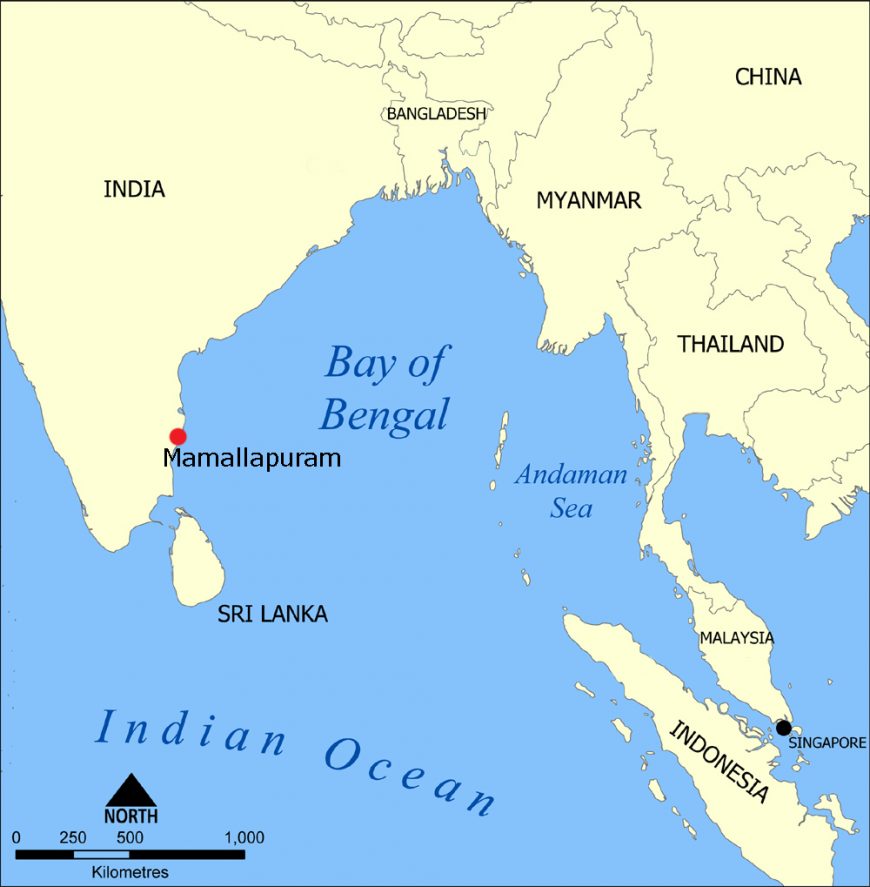
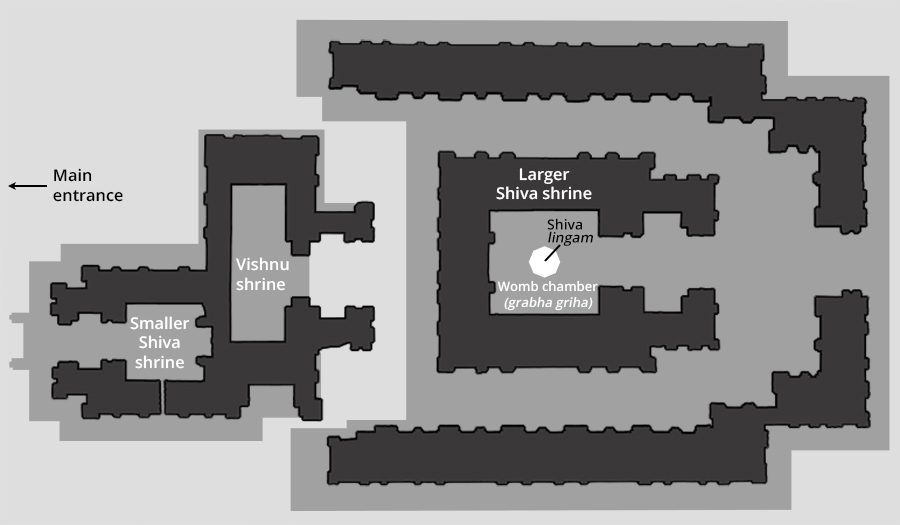
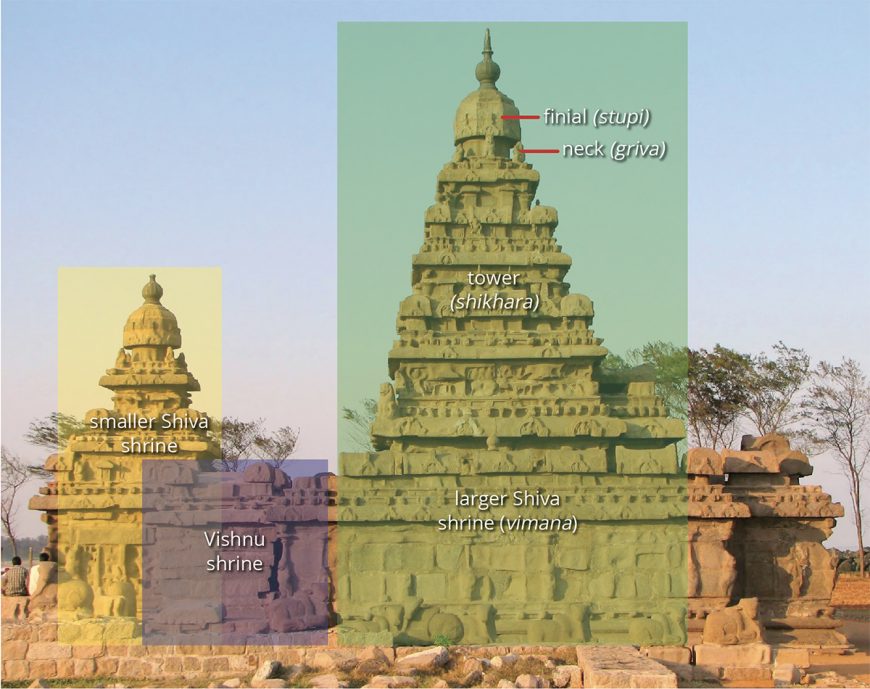
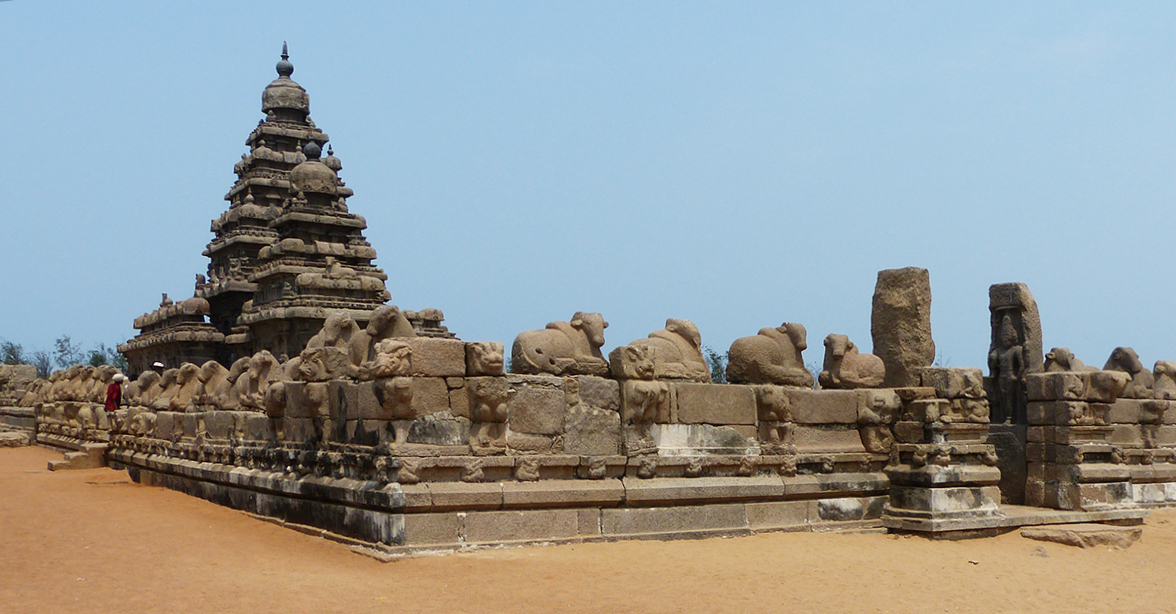
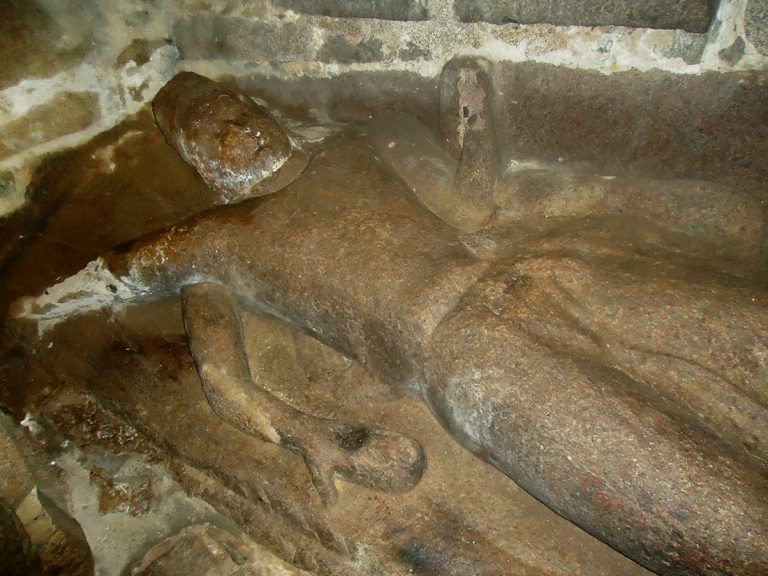
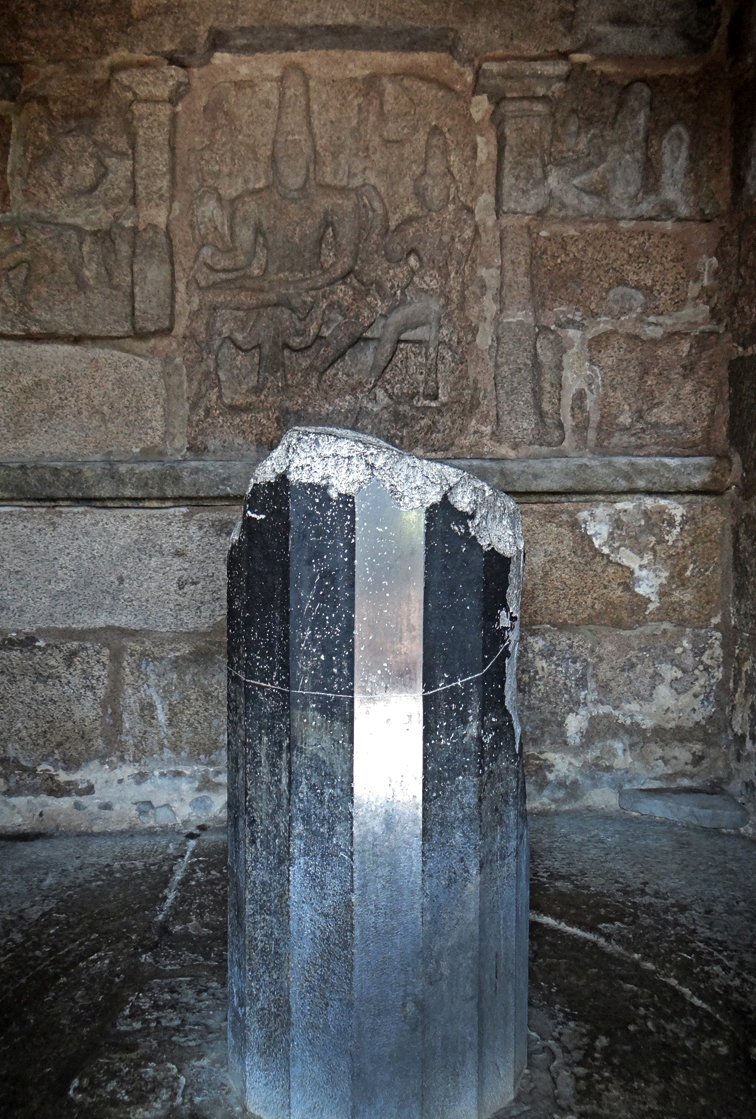
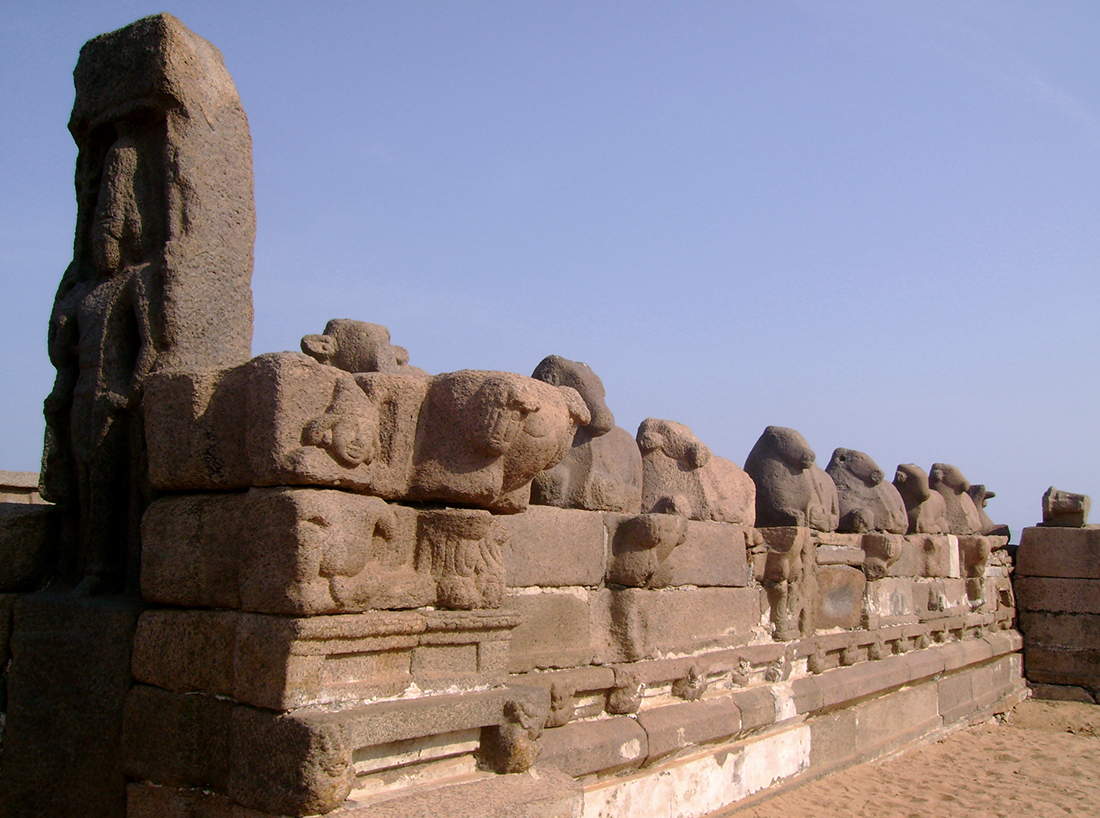





Good job ,😊👍
ReplyDeleteWell done sumit Bhardwaj..
ReplyDeleteExplained very well... 👌👍
Good work done very educational.
ReplyDeletethanks all please keep supporting keep reading.....
ReplyDelete